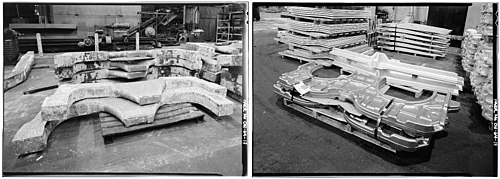Heavy Press Program
The Heavy Press Program (German: Schwere-Presse-Programm) was an American industrial project that, at the endeavors of the United States Air Force , should lead to the development of the largest extrusion and forging presses in the world. The machines built expanded the capacities of the US defense industry for the production of structural parts for aviation from light metals such as aluminum and magnesium . The project began during the Cold War in 1950 and ended as early as 1957 after the completion of six extrusion and four forging presses with forming forces of up to 50,000 American tons (~ 45,400 metric tons). The cost of building the presses, eight of which are in use to date, was $ 279 million at the time. Larger presses can be found today in Japan, France, Russia and China.
history
The idea of building heavy extrusion and forging presses was fundamentally driven by experiences during the Second World War . With several large presses, the German Reich was able to produce components for Luftwaffe aircraft in large numbers. At the same time, more complex parts could be manufactured in one piece and no longer had to be laboriously joined from several individual parts by riveting. One of the largest forging machines with a force of almost 30,000 tons and blueprints for a 50,000 ton press fell victim to dismantling by the Soviets after the war . The USA could only win much smaller presses for itself, which were shipped quickly across the Atlantic. These circumstances created fears on the American side that they could be technologically behind the USSR and justified the development of their own designs of heavy presses.
The original plan was to build 17 presses, but the scope of the project was limited to ten in 1953.
A US Air Force Lieutenant General, KB Wolfe, was a driving force behind the development project.

Built presses
| Force (metric tons) |
Press type | Manufacturer | Applied by | place | Start of operations |
|---|---|---|---|---|---|
| 12,000 | Extrusion | Schloemann | Alcoa | Lafayette , Indiana | 1953 |
| 45,500 | Forging press | Mesta Machinery | Alcoa | Air Force Plant 47 , Cleveland , Ohio | May 5th 1955 |
| 31,800 | Forging press | United Engineering | Alcoa | Air Force Plant 47, Cleveland, Ohio | 1955 |
| 7,300 | Extrusion | Loewy Hydropress | Kaiser Aluminum | Halethorpe , Maryland | |
| 7,300 | Extrusion | Loewy Hydropress | Kaiser Aluminum | Halethorpe, Maryland | |
| 7,300 | Extrusion | Loewy Hydropress | Harvey Machine Co. | Torrance , California | |
| 10,900 | Extrusion | Lombard Corporation | Harvey Machine Co. | Torrance, California | August 1957 (scrapped 1990s) |
| 45,500 | Forging press | Loewy Hydropress | Wyman-Gordon | Air Force Plant 63 , Grafton , Massachusetts | October 1955 |
| 31,800 | Forging press | Loewy Hydropress | Wyman-Gordon | Air Force Plant 63, Grafton, Massachusetts | February 1955 |
| 10,900 | Extrusion | Loewy Hydropress | Curtiss-Wright | Buffalo , New York |
Honor
The American Society of Mechanical Engineers declared the 45,500-ton Alcoa and Wyman-Gordon presses to be historic engineering milestones in 1981 and 1983, adding them to their list of Historic Mechanical Engineering Landmarks .
Individual evidence
- ↑ The Atlantic: Iron Giant , accessed February 4, 2019
- ^ Pearson, Drew (September 11, 1953), The Free Lance-Star: "Aircraft Presses Cut Back Here as Soviet Forges Ahead" , accessed February 4, 2019
- ↑ Blue, DD; Kurtz, HF (1956). "Aluminum": Minerals yearbook metals and minerals (except fuels) 1953. I. Bureau of Mines, United States Government Printing Office. pp. 143–163 , accessed February 4, 2019
- ↑ ASME: ALCOA 50,000-ton Hydraulic Forging Press , accessed February 4, 2019
- ↑ ASME: Wyman-Gordon 50,000-ton Hydraulic Forging Press , accessed February 4, 2019

